Content
Hydrangea Hot Red is distinguished by its inflorescences, which look like red-pink balls. Decorations of this kind will make any garden area attractive. The plant has unpretentiousness and relatively high winter hardiness.
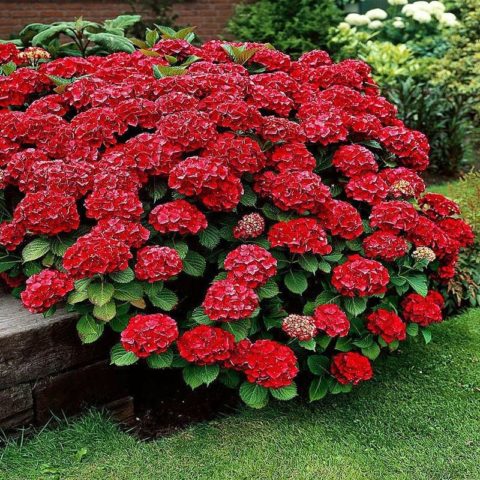
Caring for this culture is easy and even a beginner can do it
Description of hydrangea large-leaved Hot Red
Hydrangea Hot Red is a short-growing perennial shrub. Rarely can you find plants more than 1 m high. The shape of the bush is spherical. On each of the shoots, an inflorescence is formed that resembles a kind of hat. Its diameter can reach 15 cm.
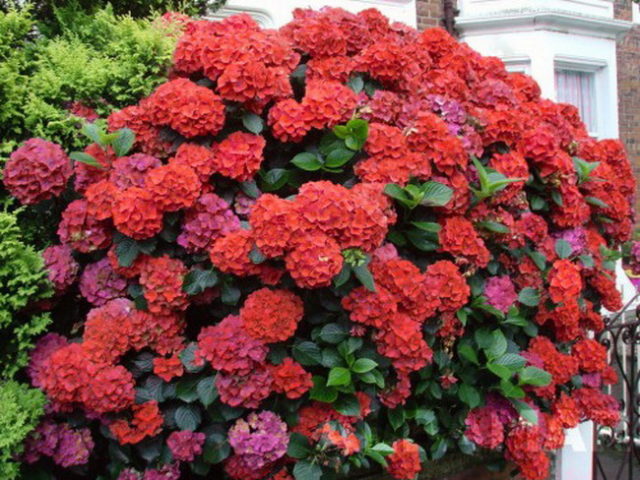
Hydrangea Hot Red has a spherical crown with a diameter of up to 1 m
The central stems of the plant are directed vertically upward, and the lateral ones are characterized by an arcuate bend. Shoots are light green in color. The leaves of the Hot Red hydrangea are large, tightly fitting to the stems and flowers. They are ovoid with a pointed end. For its size, the bush has a good growth rate, it is about 20 cm per year.
The flowering period lasts from June to September. At the same time, those buds bloom, the buds of which were laid in the fall of last season. After flowering, a box is formed with several chambers in which the seeds are located.
Hydrangea Hot Red in landscape design
Thanks to the spherical shape of the crown, the Hot Red hydrangea is able to create visual deception, expanding the space around it. This is often used to increase the visible boundaries of small areas.
Another important plus of the hydrangea in question is its color. The bright red hue always attracts attention.
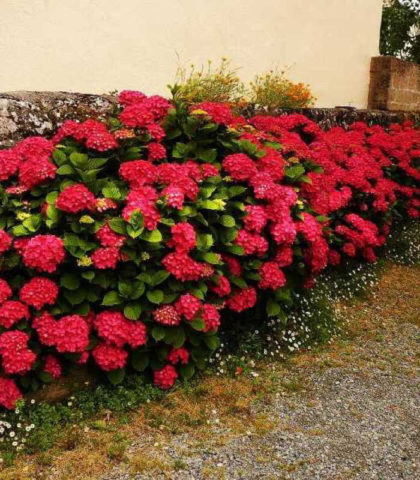
If you need to emphasize some kind of accent or distract the viewer from something, there is practically no better way than to do it with the help of Hot Red hydrangea
This culture is very popular with gardeners and designers.
Winter hardiness of hydrangea Hot Red
Hydrangea large-leaved Hot Red belongs to plants with a frost resistance zone 6b. This means that it can withstand temperatures down to -20 ° C. In areas with mild winters, you can not cover the bushes at all or limit yourself to protecting the roots (a hill of earth 20-30 cm high). In more severe climates, the branches of the bush should also be insulated.
Planting and caring for Hot Red hydrangea
In order for the Hot Red hydrangea to fully realize its potential, it is necessary to follow all the rules for planting and caring for it. It is necessary to take into account all the factors affecting flowering: the method of planting, and the composition of the soil, and proper care of the plant.
Selection and preparation of the landing site
It would be preferable to plant the Hot Red hydrangea in partial shade, and it is desirable that the plant be in the shade precisely at noon, when the heat from the sun's rays is maximum. The ideal option is the east side of the house. Thanks to this, the bush will be in the sun for half a day, and with the onset of the midday heat, it will go into the shade.
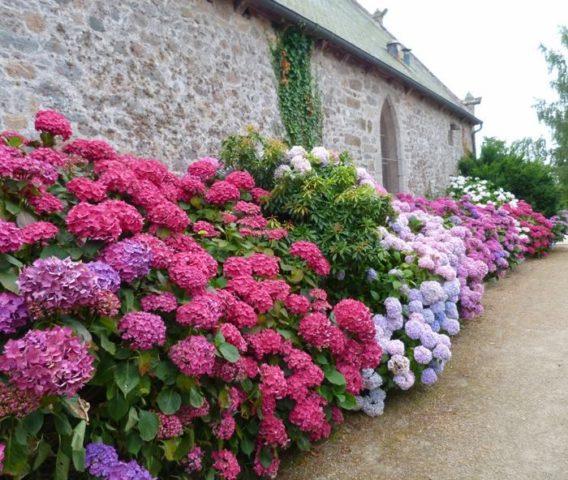
It is best to place the plant on the east side of the house.
The mineral composition of the soil is also important.The soil must be acidic: it is thanks to this that the Hot Red hydrangea has its unique color. On neutral soils, it becomes faded; on alkaline soils, the plant may not bloom at all. The optimal soil for Hot Red hydrangea is clayey or with a high humus content.
Preliminary preparation of the soil consists in the introduction of a top dressing before planting, consisting of three components: superphosphate, urea and potassium sulfate. Fertilizers are added to the soil, which will be sprinkled on the seedling during planting. The rates are determined according to the instructions.
Landing rules
The best time to plant young seedlings in the garden is spring. Autumn is a compromise, since a young plant will not tolerate the first wintering well without the formation of a vegetative part.
When planting, you can use cuttings that have sprouted earlier, but only after two years have passed from the time the roots appear on them (before planting, they are germinated in a special substrate). In the case of using purchased seedlings, they should be pre-inspected for defects in the root system and the number of buds on them. The roots of the Hot Red hydrangea should be dry, flexible and elastic.
Planting pits are located at a distance of at least 1.5 m from each other. The dimensions of the pit are 50x50x40 cm. To create hedges, trenches with a width of 50 cm to 1 m are used. The holes should be dug at least 3 months before planting, that is, they should be prepared for spring planting at the end of autumn.
A drainage layer is laid at the bottom of the pits, on top of which garden soil or a small (up to 5 cm) layer of humus is placed. Further, a low mound is formed above this layer, on the top of which a seedling is placed. Its root collar should be at ground level.
The roots of the seedling are evenly distributed over the mound and sprinkled with a prepared soil mixture. Then it is lightly tamped and watered.
Watering and feeding
Hydrangea Hot Red is a moisture-loving plant, so special attention should be paid to watering. Under normal conditions, watering should be followed at intervals of 2 weeks. In dry weather, the time between watering is reduced to one week, in rainy weather they are guided by the state of the top layer of the soil - it should not be dry. The norm is 1 bucket of water under the bush.
For irrigation, use warm water, to which add 3 g of potassium permanganate. Such an additive performs a preventive function and protects the plant from fungal diseases. Watering is carried out in the morning or evening.
Hydrangea Hot Red has a high growth rate, so feeding, especially for young plants, is a must. The first is carried out until the end of June, it consists of ammonium or potassium sulfate. For this, 30 g of the substance is dissolved in 10 l of water. The frequency of application is 14 days.
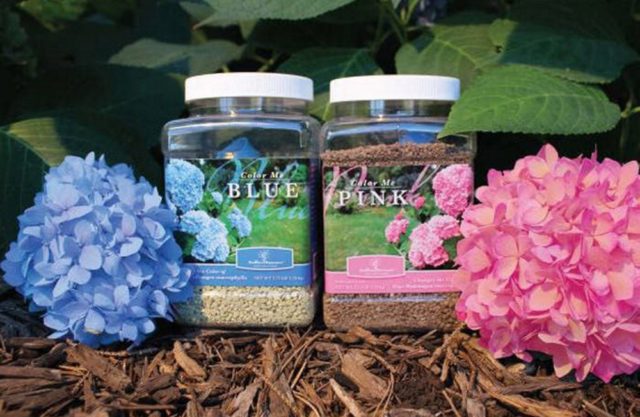
Specialized feeding for hydrangea depends on its color
The second is produced from July to October; it is based on complex fertilizers, in which phosphorus prevails. Approximate composition: 70 g of superphosphate and 45 g of potassium sulfate are dissolved in 10 liters of water. The frequency is the same as the first - 14 days. Before the onset of winter, the last feeding is made from humus with the addition of bone meal.
Pruning Hydrangea Hot Red
The plant belongs to the first pruning group. This means that Hot Red hydrangea flower stalks are formed on last year's shoots. Consequently, the plant needs cosmetic and sanitary pruning, performed in the spring before the start of sap flow.The plant is not cut off entirely, but only to rejuvenate it: every fourth shoot over 3 years old is removed.
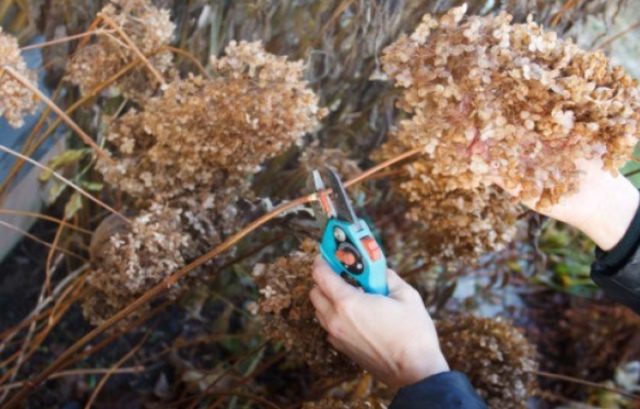
At the end of autumn, faded inflorescences are necessarily cut off.
If this is not done, the branches may break under the weight of the snow cover. In addition, any shoots growing inside the bush should be removed.
Preparing for winter
Preparation of Hot Red hydrangea for winter occurs after autumn pruning and consists in warming the bush, depending on weather conditions. In mild climates, only sprinkle earth on the base of the plant, protecting the root system from frost.
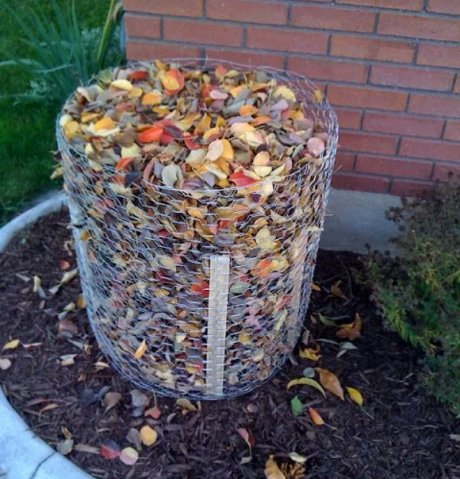
Warming hydrangea branches with an external frame
In colder climates, branches are also insulated. Unlike other varieties of hydrangea, Hot Red is not laid on the ground, but a standing shelter is erected around the bush (for example, by making it a steel mesh frame). In this case, the bush is tied into a bundle using twine, and the space between the branches and the frame is filled with straw or foliage. Outside, the entire structure is wrapped with plastic wrap.
Reproduction
Reproduction of Hot Red hydrangea is carried out mainly in a vegetative way. Seed is practically not used, since it takes a lot of time and effort to form an adult flowering bush.
The main breeding methods:
- cuttings;
- layering;
- dividing the bush.
Most often, the first method is used, as the most effective. Cuttings are cut from last year's shoots 15 cm long so that they have at least two buds. Root formation in water or substrate occurs over several weeks, after which they should be grown for two years in a separate container to form seedlings ready for planting in open ground.

Cutting a large root during vegetative propagation is one of the most affordable ways
Reproduction by layering and dividing the Hot Red hydrangea bush is performed according to the standard technique. The best time for this is early spring.
Diseases and pests
In general, the Hot Red hydrangea has a fairly high level of immunity and is able to independently cope with diseases and pests. However, changing environmental conditions, excessive moisture or dryness, and the absence of any of the nutritional components can weaken the bush's resistance.
In dry weather, the plant can attack the spider mite. Its symptomatology is the appearance of cobwebs on the underside of the leaves. In this case, there is a yellowing of parts of the plant, followed by their drying and falling off. In this case, the bush should be sprayed with insecticides, for example, Aktellik.
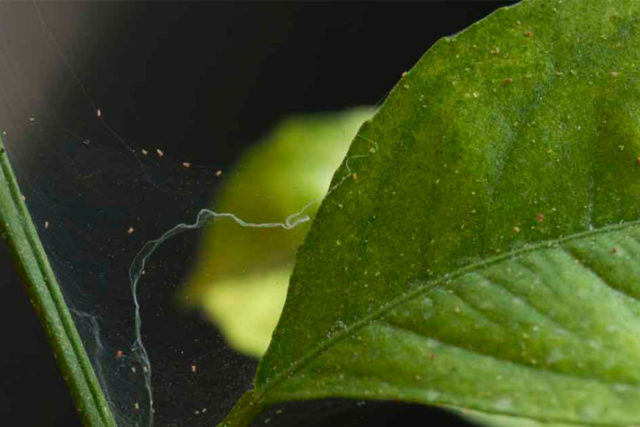
Leaves affected by spider mites have cobwebs on their surface
If oily spots appear on the leaves, turning yellow over time and then blackening, this means that the bush is attacked by downy mildew. To combat it, spraying with copper-containing preparations is used (copper sulfate 3%, Bordeaux liquid 1%, etc.)
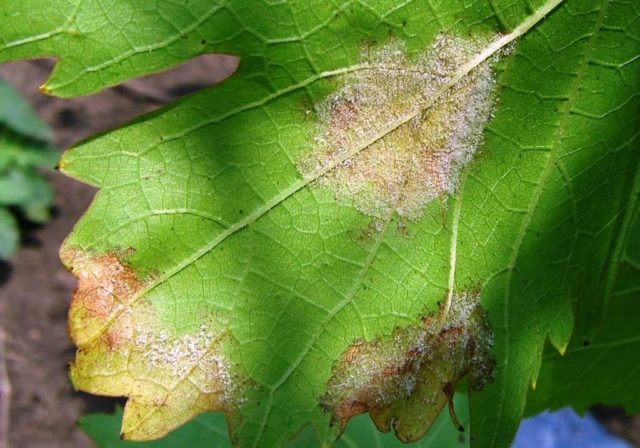
Downy mildew requires immediate treatment
In cold and humid weather, the plant can be affected by rust - the appearance of small round brown spots on the leaves. Spraying the bush with copper sulfate also saves from this disease.
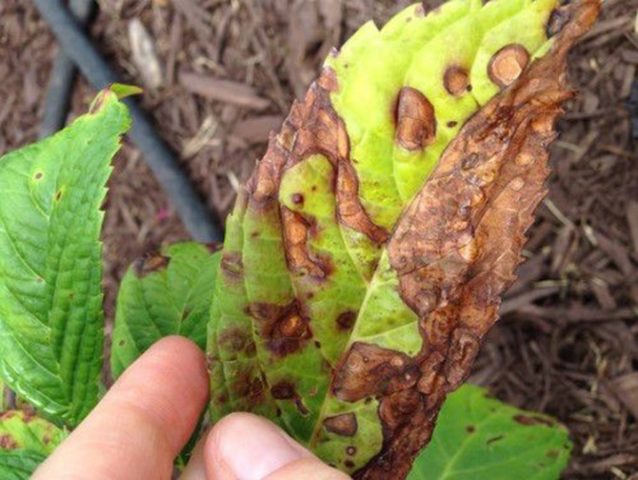
Rust often develops on weakened seedlings
Conclusion
Hydrangea Hot Red is a relatively unpretentious shrub with a spherical crown and beautiful large inflorescences of a bright red hue. It is widely used in landscape design due to its decorative effect. Caring for a Hot Red hydrangea is simple and quite within the power of novice gardeners. The plant has good winter hardiness and resistance to diseases and pests.








